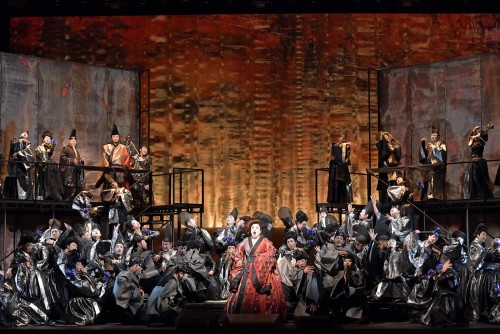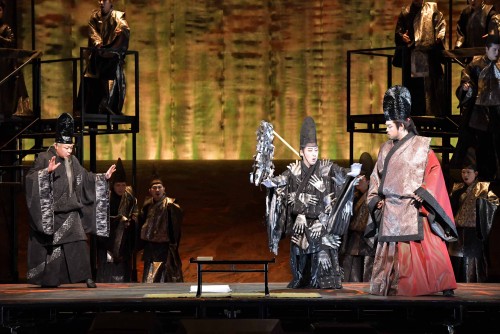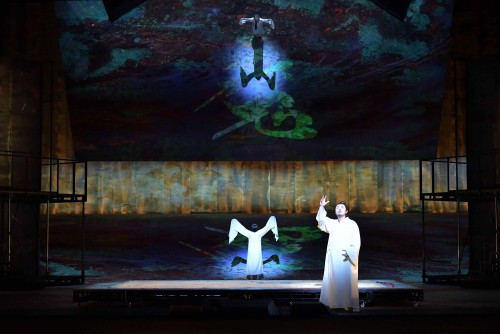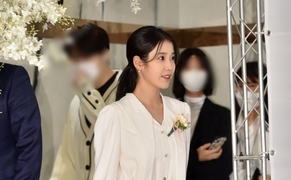 |
| A scene of the opera "Asters", the world premiered by New National Theatre Tokyo/ Photo by TERASHI Masahiko ⓒNew National Theatre, Tokyo Asters |
This review of opera Asters was written after viewing its world premiered on the invitation of the New National Theatre Tokyo. Opera Asters had its world debut February 20 in the Opera Palace of NNTT. After Ono Kazushi joined last October as the new Artistic Director, NNTT announced an ambitious goal to keep a running streak of presenting Japanese opera to the world. The first of that project is Asters. The opera marked 70% purchased tickets on the first day, a great success displaying a high level of attention.
Based in Heian period Japan, the protagonist, Muneyori, is born in a family with a long legacy in poetry and prominent of its anthologies published every generation ordered by the king. Muneyori fights his natural talent as a poet and his father who never thinks twice of his son’s future as a poet. Instead, he chooses archery and does not hesitate to take lives, but at the same time, he is kept in an endless cycle of afflictions pondering on the path he is meant to take.
NNTT took the story full of tension and abstractions and gave new life to it as a modern opera with splendid display and dramatic musical sensations. The opera took over two years in the libretto and composing, a sign of attention NNTT poured into the planning and production of the piece. Even more so as the opera is the very first of commissioned works lined up for this season pushed by new Artistic Director Ono Kazushi.
 |
| A scene of the opera "Asters", the world premiered by New National Theatre Tokyo/ Photo by TERASHI Masahiko ⓒNew National Theatre, Tokyo Asters |
Asters was created with music composed by Nishimura Akira and the libretto of Sasaki Mikiro. Collaboration between the composer and librettist is essential element in operas. This opera, which is performed in Japanese language, is full of lines rich in its literary value, and the rich expressions captured the rhythm of the language creating an excellent blend with the music which clearly resonated through the audience.
Unlike operas from Italy or Germany, most Asian creators struggle to form their language in a manner that suits opera. Asters showed great progress in operas performed in Japanese. This progress is thought to have the researches and efforts made in Japanese librettos for operas since the 1950s.
Topped on the swift movements of strings, the overture submerges into the deepest depths while the past of the protagonist and reasons for his actions are explained. Then, there is a sudden transition to a wedding of Muneyori and Princess Utsuro, a daughter of a wealthy and powerful man.
Throughout the story, there are two female and two male characters that stand on the other end of each other with the protagonist in the center. Princess Utsuro, the wife-to-be by an arranged marriage, and Chigusa, the woman Muneyori loves, the father who forces him to carry on the family business and Uncle Yumimaro who teaches him archery are the characters in juxtaposition.
Baritone Takada Tomohiro, with the graveness and presence in his voice, does an excellent job creating a Muneyori filled with afflictions and anguish. In creating his character, a villain with a conflicted conscience, his attention to detail in using full range of his chest voice and falsetto and depicting emotions forms a good foundation for the entire performance. Mezzo soprano Shimizu Kasumi who plays Princess Utsuro was a strong presence on stage. In the wedding scene, one of the most highlighted scenes in the opera, Princess Utsuro takes you by surprise as he sings a song full of lust. In the scene, Shimizu Kasumi makes a strong impression in the audience with a rich and powerful performance.
The beautiful maiden Chigusa is the incarnation of a little vixen that was shot by Muneyori’s arrow. Her appearance brings the opera passing between the real world and the world of fantasy. Chigusa sings a cadenza dressed with a skillful coloratura. The elaborate cadenza decorated with nonharmonic tones did a great for presenting a mysterious and captivating Chigusa.
 |
| A scene of the opera "Asters", the world premiered by New National Theatre Tokyo/ Photo by TERASHI Masahiko ⓒNew National Theatre, Tokyo Asters |
The opera had a good deal of ensembles enough to call it an opera of ensembles. The quartet of Muneyori, Chigusa, Princess Utsuro, and the footman, Tonai, who tries to seduce her in Act 2 is especially memorable. Each singer deliberately sing in different styles in discord clearly projecting their desires that are unreconcilable. The orchestra builds up the tension to its hike as they play with no tune and only using rhythm to support the singing, accentuating the fallout.
Heita, who appears in the second half and is standing in the opposite position of Muneyori symbolizes Muneyori’s ideal other self. The music leads a constant height of tension throughout the performance until Heita turns that into a harmony, bringing a sense of peace, expressing Heita’s inner peace. Contrary to Muneyori, Heita leads his life sculpting Buddhist statues in a rocky mountain without ever questioning his vocation and his reason for existence. The duet of the two is enough to be named the climax of the peace. As two egos within oneself face each other, what sustained Muneyori’s real world collapses.
Nishimura Akira roots his music in a rich and voluminous orchestra and invites various types of instruments, a colorful palette that reminds you of Richard Strauss. Every scene he brings Leitmotiv and organically connects the entire piece.
The level of musical completeness owes greatly to Tokyo Metropolitan Symphony Orchestra conducted by Ono Kazushi. The long-lasting partnership of the Tokyo Metropolitan and Ono built a sturdy foundation that kept an unshaking concentration until the end of the performance. Especially notable were the string part with precise and well-planned structure and the brass part that led powerful moments in the opera with flawless techniques.
Producer Oida Yoshi is a world-class actor and producer. The stage is a canvas of metallic colors and mirrors, a lens that transcends time and space, but he managed to make the moving stage allow the staff to move about like puppeteers of Bunraku (traditional Japanese puppet theatre) which rings with features from the traditional Japanese theatre. The final scene where Muneyori shoots an arrow at the Buddhist statue and collapses with it was a moment of symbolism leaving a rich afterthought.
 |
| A scene of the opera "Asters", the world premiered by New National Theatre Tokyo/ Photo by TERASHI Masahiko ⓒNew National Theatre, Tokyo Asters |
As mentioned above, the Japanese title of this opera is The Story of Zion (紫苑物語). As Muneyori’s afflictions and suffering become greater, he takes more lives. He plants flowers for every life he takes and makes a garden. The flowers in the garden reflect Muneyori’s will to remember and remind himself of who he is. This is where the original title comes from.
At the press conference after the first show, the Ono Kazushi, the Conductor of Asters and the artistic director of NNTT told the press, “Ishikawa Jun had done nearly no writing during World War II, and this was the most well-known piece he wrote after the war. Muneyori shows painful afflictions on what a path of a true artist is. Muneyori eventually fades away, but his poets live on.”
Muneyori’s conflict and search can by identified with by many today. What is a true artist? How does one keep on that road? Perhaps, they are questions posed by the New National Theatre Tokyo to its audience and two itself.
Supervision : Haejin Lee
 |
Most Read
-
1
-
2
-
3
-
4
-
5
-
6
-
7





















